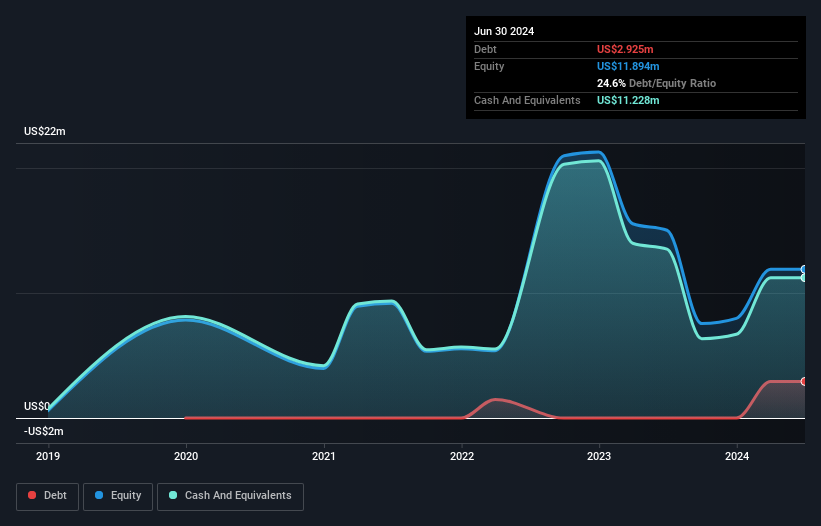Howard Marks put it nicely when he said that, rather than worrying about share price volatility, 'The possibility of permanent loss is the risk I worry about... and every practical investor I know worries about.' When we think about how risky a company is, we always like to look at its use of debt, since debt overload can lead to ruin. Importantly, ZOOZ Power Ltd. (NASDAQ:ZOOZ) does carry debt. But should shareholders be worried about its use of debt?
When Is Debt Dangerous?
Generally speaking, debt only becomes a real problem when a company can't easily pay it off, either by raising capital or with its own cash flow. If things get really bad, the lenders can take control of the business. However, a more usual (but still expensive) situation is where a company must dilute shareholders at a cheap share price simply to get debt under control. By replacing dilution, though, debt can be an extremely good tool for businesses that need capital to invest in growth at high rates of return. When we examine debt levels, we first consider both cash and debt levels, together.
Check out our latest analysis for ZOOZ Power
How Much Debt Does ZOOZ Power Carry?
As you can see below, at the end of June 2024, ZOOZ Power had US$2.93m of debt, up from a year ago. Click the image for more detail. But it also has US$11.2m in cash to offset that, meaning it has US$8.30m net cash.

A Look At ZOOZ Power's Liabilities
According to the last reported balance sheet, ZOOZ Power had liabilities of US$5.12m due within 12 months, and liabilities of US$1.01m due beyond 12 months. Offsetting this, it had US$11.2m in cash and US$245.7k in receivables that were due within 12 months. So it can boast US$5.35m more liquid assets than total liabilities.
This surplus suggests that ZOOZ Power is using debt in a way that is appears to be both safe and conservative. Given it has easily adequate short term liquidity, we don't think it will have any issues with its lenders. Succinctly put, ZOOZ Power boasts net cash, so it's fair to say it does not have a heavy debt load! When analysing debt levels, the balance sheet is the obvious place to start. But you can't view debt in total isolation; since ZOOZ Power will need earnings to service that debt. So if you're keen to discover more about its earnings, it might be worth checking out this graph of its long term earnings trend.
In the last year ZOOZ Power had a loss before interest and tax, and actually shrunk its revenue by 35%, to US$507k. To be frank that doesn't bode well.
So How Risky Is ZOOZ Power?
We have no doubt that loss making companies are, in general, riskier than profitable ones. And in the last year ZOOZ Power had an earnings before interest and tax (EBIT) loss, truth be told. Indeed, in that time it burnt through US$13m of cash and made a loss of US$13m. Given it only has net cash of US$8.30m, the company may need to raise more capital if it doesn't reach break-even soon. Even though its balance sheet seems sufficiently liquid, debt always makes us a little nervous if a company doesn't produce free cash flow regularly. There's no doubt that we learn most about debt from the balance sheet. However, not all investment risk resides within the balance sheet - far from it. For example, we've discovered 4 warning signs for ZOOZ Power (3 make us uncomfortable!) that you should be aware of before investing here.
If you're interested in investing in businesses that can grow profits without the burden of debt, then check out this free list of growing businesses that have net cash on the balance sheet.
Valuation is complex, but we're here to simplify it.
Discover if ZOOZ Strategy might be undervalued or overvalued with our detailed analysis, featuring fair value estimates, potential risks, dividends, insider trades, and its financial condition.
Access Free AnalysisHave feedback on this article? Concerned about the content? Get in touch with us directly. Alternatively, email editorial-team (at) simplywallst.com.
This article by Simply Wall St is general in nature. We provide commentary based on historical data and analyst forecasts only using an unbiased methodology and our articles are not intended to be financial advice. It does not constitute a recommendation to buy or sell any stock, and does not take account of your objectives, or your financial situation. We aim to bring you long-term focused analysis driven by fundamental data. Note that our analysis may not factor in the latest price-sensitive company announcements or qualitative material. Simply Wall St has no position in any stocks mentioned.
About NasdaqCM:ZOOZ
ZOOZ Strategy
Engages in developing, manufacturing, marketing, and selling energy store solutions for electric vehicles in Israel, Germany, the United Kingdom, and the United States.
Medium-low risk with limited growth.
Market Insights
Community Narratives




